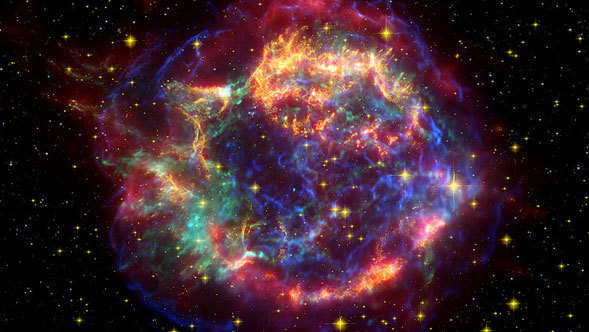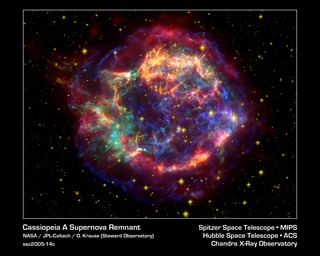
News Release • August 25th, 2005 • feature05-17 •
Written by Linda Vu
Spitzer Science Center
Four days after its launch on August 25, 2003, NASA's Spitzer Space Telescope opened its infrared eyes for the first time and immediately performed beyond all expectations by providing the world with one of the deepest infrared images ever taken. Two years later, Spitzer continues to surpass expectations by uncovering a hidden universe teeming with warm stellar embryos, chaotic planet-forming disks, majestic galaxies, hidden black holes, remnants of dead stars, and much more.
Just nine months after the telescope began its initial "science" observations in December 2003, Spitzer astronomers announced for the first time that planets are built in massive collisions by bodies as big as mountain ranges over a long period. One year later, in a collaborative effort with NASA's Hubble Space Telescope (HST), Spitzer and HST scientists publicly verified that the dusty disks circling stars are indeed planetary construction zones. By 2005, Spitzer had discovered an asteroid belt circling a star similar to our Sun and learned that planets will form and revolve around small, failed stars, or brown dwarfs, a little bigger than Jupiter. All of these discoveries provided scientists with valuable insights into the formation of planets.
"Spitzer is a very powerful and timely approach to answer questions of the origins of life and whether other planets like Earth exist," said Spitzer Science Center Deputy Director Dr. George Helou. "Until Spitzer flew we could only measure massive stars."
Earlier this year, Spitzer astronomers also devised a new technique for detecting light directly from planets outside our solar system, called the "eclipsing phenomenon." After measuring the infrared light of two known planets and their stars, astronomers waited until the planets were eclipsed by their suns to measure the light of the star alone. From this information they pinpointed exactly how much light was being emitted directly from the planets. This allowed astronomers to do direct comparisons between different planets, define their size, orbit, and determine whether any of these systems are suitable for life.
In addition to planets, Spitzer's surprise discoveries also included the universe's "missing" population of supermassive black holes, or quasars. While visible light cannot escape the immense gravitational pull of a black hole, X-rays can. By measuring the amount of X-rays in the universe with other observatories and comparing them with the number of known quasars, scientists found a discrepancy and suspected that there must be a population hiding behind cosmic dust. Until Spitzer's sensitive infrared eyes, no telescope could pierce though this thick dust to confirm that these missing quasars existed.
"The Old, The Cold and the Dirty"
"Spitzer's superb sensitivity allows us to see 'the old, the cold and the dirty' objects in the universe," said Spitzer Project Scientist Dr. Michael Werner.
As the universe expands, starlight from distant galaxies is shifted from blue to red and, ultimately, into the infrared. Because distance equals time in space, radiation emitted by stars, galaxies, and other objects in the early universe now lies partially in the infrared and can be detected by Spitzer. This is the "old" universe that Spitzer probes.
Similarly, since infrared radiation is associated with heat, all objects warmer than absolute zero (-459 degrees Fahrenheit or -273 degrees Celsius) emits in the infrared, and can be detected by Spitzer. Thus, Spitzer reveals the "cold" objects hiding in the dark corners of the universe.
In the past, thick clouds of cosmic dust have hidden stars, black holes, asteroids, comets, and planets from optical telescopes. However, because the dust and rocks surrounding a star will naturally absorb the star's heat and re-radiate it in the infrared, Spitzer also studies the universe's "dirty" objects.
"I never thought dust and dirt were so beautiful until I saw images from Spitzer. It?s wonderful," said Dr. Kim Weaver, Spitzer program scientist at NASA headquarters.
"In the end we are pursuing a science which is a very natural science," said Helou. "It is the most in-depth observation of the universe that we live in. And we're just getting started!"
The telescope is the last of NASA's Great Observatories Program. Following in the tradition of the Hubble Space Telescope (HST) which peers at the cosmos in visible light, and the Compton Gamma Ray (CGRO) and Chandra X-ray Observatories (CXO) which detect the universe's most violent explosions using Gamma Ray and X-ray light, Spitzer exposes objects that are old, cold, and shrouded in dust by observing the infrared sky.





